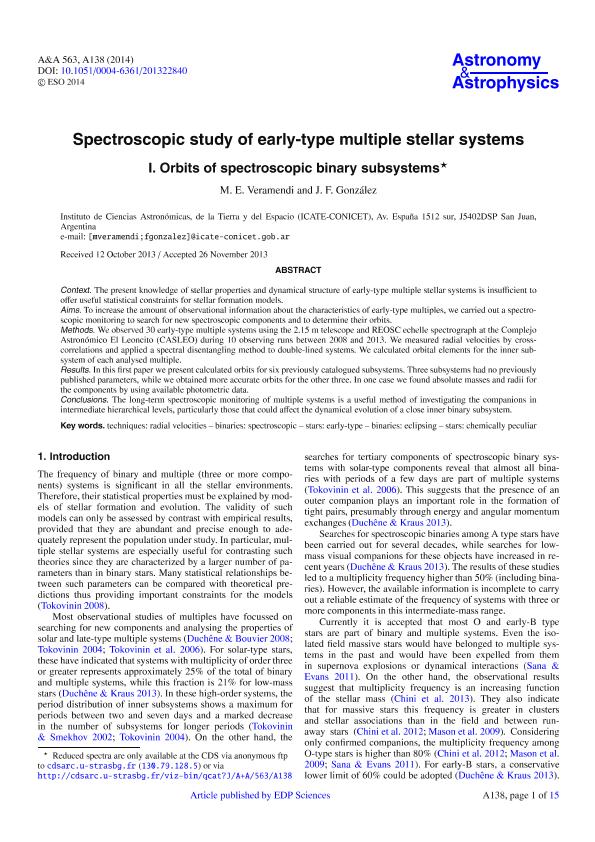Mostrar el registro sencillo del ítem
dc.contributor.author
Veramendi Pont, María Eugenia

dc.contributor.author
Gonzalez, Jorge Federico

dc.date.available
2016-03-21T20:44:56Z
dc.date.issued
2014-03
dc.identifier.citation
Veramendi Pont, María Eugenia; Gonzalez, Jorge Federico; Spectroscopic study of early-type multiple stellar systems. I. Orbits of spectroscopic binary subsystems; EDP Sciences; Astronomy And Astrophysics; 563; 3-2014; 1-15
dc.identifier.issn
0004-6361
dc.identifier.uri
http://hdl.handle.net/11336/4892
dc.description.abstract
Context. The present knowledge of stellar properties and dynamical structure of early-type multiple stellar systems is insufficient to offer useful statistical constraints for stellar formation models.
Aims. To increase the amount of observational information about the characteristics of early-type multiples, we carried out a spectroscopic monitoring to search for new spectroscopic components and to determine their orbits.
Methods. We observed 30 early-type multiple systems using the 2.15 m telescope and REOSC echelle spectrograph at the Complejo Astronómico El Leoncito (CASLEO) during 10 observing runs between 2008 and 2013. We measured radial velocities by cross-correlations and applied a spectral disentangling method to double-lined systems. We calculated orbital elements for the inner subsystem of each analysed multiple.
Results. In this first paper we present calculated orbits for six previously catalogued subsystems. Three subsystems had no previously published parameters, while we obtained more accurate orbits for the other three. In one case we found absolute masses and radii for the components by using available photometric data.
Conclusions. The long-term spectroscopic monitoring of multiple systems is a useful method of investigating the companions in intermediate hierarchical levels, particularly those that could affect the dynamical evolution of a close inner binary subsystem.
dc.format
application/pdf
dc.language.iso
eng
dc.publisher
EDP Sciences

dc.rights
info:eu-repo/semantics/openAccess
dc.rights.uri
https://creativecommons.org/licenses/by-nc-sa/2.5/ar/
dc.subject
Techniques: Radial Velocities
dc.subject
Binaries: Spectroscopic
dc.subject
Stars: Early-Type
dc.subject
Binaries: Eclipsing
dc.subject
Stars: Chemically Peculiar
dc.subject.classification
Astronomía

dc.subject.classification
Ciencias Físicas

dc.subject.classification
CIENCIAS NATURALES Y EXACTAS

dc.title
Spectroscopic study of early-type multiple stellar systems. I. Orbits of spectroscopic binary subsystems
dc.type
info:eu-repo/semantics/article
dc.type
info:ar-repo/semantics/artículo
dc.type
info:eu-repo/semantics/publishedVersion
dc.date.updated
2016-03-30 10:35:44.97925-03
dc.journal.volume
563
dc.journal.pagination
1-15
dc.journal.pais
Francia

dc.journal.ciudad
Paris
dc.description.fil
Fil: Veramendi Pont, María Eugenia. Consejo Nacional de Investigaciones Cientiâficas y Tecnicas. Centro Cientifico Tecnologico San Juan. Instituto de Ciencias Astronomicas de la Tierra y del Espacio; Argentina
dc.description.fil
Fil: Gonzalez, Jorge Federico. Consejo Nacional de Investigaciones Cientiâficas y Tecnicas. Centro Cientifico Tecnologico San Juan. Instituto de Ciencias Astronomicas de la Tierra y del Espacio; Argentina
dc.journal.title
Astronomy And Astrophysics

dc.relation.alternativeid
info:eu-repo/semantics/altIdentifier/url/http://www.aanda.org/articles/aa/abs/2014/03/aa22840-13/aa22840-13.html
dc.relation.alternativeid
info:eu-repo/semantics/altIdentifier/doi/http://dx.doi.org/10.1051/0004-6361/201322840
dc.relation.alternativeid
info:eu-repo/semantics/altIdentifier/doi/10.1051/0004-6361/201322840
Archivos asociados
